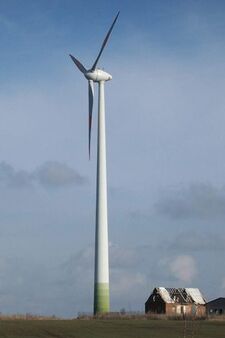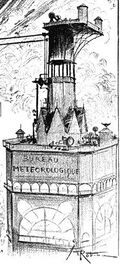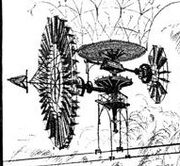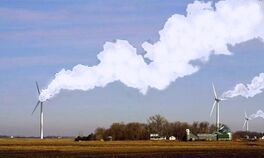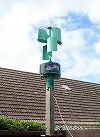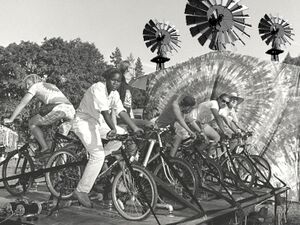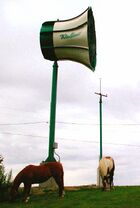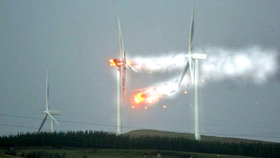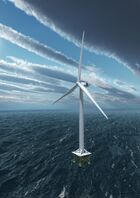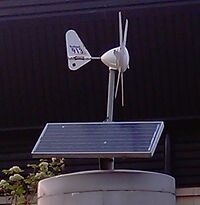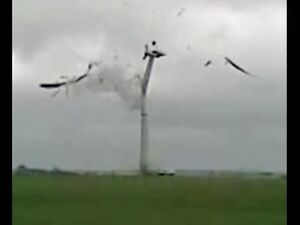Wind generators
Huge numbers of wind generators are springing-up on our hilltops, forests of giant fans turning sedately against the skyline. More seem to be appearing every day. But, why? What purpose do they serve?
Well, everyone must be familiar with the issues surrounding Global Warming, which threatens to do irreparable damage to the climatic conditions on Planet Earth if we keep on releasing carbon into the atmosphere. Wind generators are an attempt to address this problem, and one of the most revenue-effective so far found.
Operating Principle
How do they work, then? This is best shown by analogy. Computer chips generate heat, lots of it, and if your computer's processor didn't have a fan, the hot air would build-up inside the case until the thing fried itself. The fan shifts the hot air, keeping the processor cool. Modern computers contain a temperature sensor, so that when the processor is working hard, the fan runs faster.
Likewise the wind generator, working to the same principle on a larger scale, cools our planet by keeping the air shifting.
On some days there may be enough natural wind to cool the planet, in which case the wind generators will (depending on model) stop altogether, or just freewheel with the breeze. On days when heat buildup is a problem, the huge, powerful internal motor will kick-in, turning the blades. The airflow this creates will, if correctly oriented, both dissipate the excess heat and provide the additional benefit of blowing away the carbon your industry is producing before it has a chance to settle. Where the carbon ends-up is not really your concern, so long as it lands on someone else's territory.
Development
It is known from the writings of Hypatia of Cyrene that the Ancients understood the principles of, and made occasional use of climate control by generated wind. However, the mere mention let alone construction of any 'Ventus ex Machina' artifact was prohibited by the Emperor Claudius following a heated dispute at the chariot races of 45 AD, in which the Greens and a rival gang, the Deniiarii, trashed a large part of the city of Rome.
The first draft proposal for large-scale wind generation in the modern era was tabled by 19th century French inventor Albert Robida. Robida's designs, though they would probably have been effective, were never implemented owing to the lack of suitable hardware. Like many Victorian engineers he had based his designs on steampunk technology, overlooking the fact that this would be unavailable until over a hundred years on, in the late 20th century.
Thus, the idea lay dormant until the hippie era when 'alternative' thinkers revived it, with a view to improving their cash-crop yields by creating more favourable growing conditions through weather control.
These experimental wind generators of the hippie era were scorned by the conventional utility companies as impractical and useless. This was partly because of their small size and low power, many experimental units operating from car batteries or the like. Though, a more significant reason was perhaps that it had yet to be realized that economies of subsidy would apply to larger units, making them a more feasible engineering project.
Additional Benefits
A further beneficial effect, and frequent reason for the deployment of wind generators, concerns the urgent matter of controlling greenhouse gases. Greenhouse gases, particularly those which include a percentage of CO2, are known to be damaging to the current political climate, and therefore measures have been mandated to prevent the local buildup of such gases. The extent of this issue will obviously depend on the concentrations of greenhouses in any given area, whether bottled gas supplies are used to supplement the gas naturally produced by internal vegetation, and whether these greenhouses suffer leaks to the environment of their internal atmosphere. Nevertheless, to comply with current environmental legislation it is recommended that all large-scale horticultural operations should install sufficient wind-generator capacity to provide adequate dispersal of all released gases. Although private gardeners are not yet affected by this legislation, many are preparing for the likely introduction of rules requiring all greenhouses, however small, to be fitted with a wind-generator.
Unlike other industrial plant, wind generators never emit large clouds of choking smoke or carbon. On relatively few occasions, they may emit clouds of harmless, carbon-neutral steam. This has sometimes been mistaken for smoke by observers. The fact that the wind generator itself was reported to be emitting a red glow, or to have disintegrated shortly afterwards was probably due to the observer having been smoking something himself. That never happens.
Design Variations
Early wind generators were of numerous and varied designs, but modern units have largely standardized on the aircraft-propellor principle, this proving to be the most efficient. The propellor typically being mounted on a tall tower with a pivoting head, to allow the cooling blast to be aimed in the required direction, for example that of the nearest heat-producing zone, such as a city or industrial complex.
This propellor design is most suited to providing a linear stream of cooling air, and several operating in unison are easily capable of redirecting the isobars in the local region, thereby determining the local weather.
The fundamental principle of the propellor design can be expressed as
Where H is the height of the central tower, and D is the diameter of the turbine.
Many early attempts at propellor-based designs were unsuccessful, owing to this being poorly understood at the time. Here we see one such example, which though not a success as a wind generator, was nevertheless retained for its aesthetic properties.
Other designs, for example the vertically-mounted Savonius Rotor, are more suited to producing a rotational column of air, and with careful control of power-input are thus capable of counteracting cyclonic or anticyclonic meteorological conditions. Great care must however be taken with the use of this type; should the governor lose control of the rotor's RPM, there is a very real risk of a destructive tornado being initiated.
Power Sources
As is often quoted, it requires very large amounts of power to keep these turbines revolving. Early small-scale experiments relied on car batteries or the like as the power source, and vehicle starters as the motive power. Apart from the limited output, this was a high-maintenance arrangement, the batteries needing regular charging, and the mechanical aspects of the construction being vulnerable to storm-damage. Larger industrial-scale units may rely on the Electricity Grid where this is available. Where electrical power is not available -and on most hilltops it is not- then a nuclear installation is the preferred solution. The nuclear plant typically has to be sited underground, to avoid local nature-lovers complaining about their view being spoilt by large concrete buildings. In fact, to avoid attacks by Greenpeace and the like, even the fact that these hilltop-installations are nuclear-powered has been kept a closely-guarded secret.
Where power is provided by way of fossil fuel, the carbon released into the atmosphere by the generating plant will partly offset any beneficial effect of the wind generator itself. As opponents of the technology have stated, it is in fact uncertain whether the beneficial effect is even of sufficient magnitude to counteract the global-warming costs of generating the power needed to run the units. Thus the IOA have concluded that the only class of installation which is certified to provide environmental benefits is that which is powered by 'alternative' and hence non carbon monoxide emitting sources.
The typical power unit will serve ten or twenty wind generators. At its heart is a graphite-moderated Plutonium-240 core, cooled by tritium dioxide circulating at a pressure of 2400 bar. This primary coolant is, after superheating in a secondary lithium deuteride stage, led directly to a bank of double acting steam pistons, driving a horizontally-mounted flywheel of around 24ft diameter. From this flywheel, leather belts take the motive power to vertical shafts within each of the wind generator towers. Atop the tower, a crown wheel couples this shaft to the propellor. Power output is regulated manually, by a 1.25-inch gate valve in the main coolant line.
In regions where no fossil fuel or uranium is available, it may be necessary to fall back on traditional approaches such as donkeys yoked to capstans, or massed bicycles coupled to vehicle alternators to provide the electricity to run the wind generators.
Manufacture
Most of the wind generators in use today have been manufactured by the Swan Match Company of Denmark, and hence bear their distinctive trademark on the nacelle. Owing to the construction techniques used, the towers supporting these models will typically be a Swedish aspen tree trunk, topped with a red phosphorus coating. Propeller blades have a sandpaper coating for increased grip on the airflow. This has the slight disadvantage that should a blade rub on the top part of the pole, for example when flexing in high winds, the whole thing may catch fire.
Typical cost for a 300m-diameter unit is now $230 million. (2011) Although, cheaper Chinese copies (with free postage) are starting to appear on Ebay.
Reports from industry are that Dyson, Inc. are planning to enter this market with a newly patented, high-performance 'propellerless' design. This will in fact use exactly the same propeller as the conventional type, but mounted horizontally in an underground cavern. Above ground, a vertical duct will take the air to a ring-like contrivance that not only distributes the air more evenly, but also looks like a super-cool gadget everyone should want near to their home. Downside is that these models are likely to be so expensive that each country will only be able to afford one. That is, until the patent runs out.
Siting
Many wind generators are sited on hilltops. A particular advantage of the siting of these units atop very stable granite or igneous rock-formations is that no special provisions need be made regarding nuclear waste, which is simply allowed to trickle down into fissures in the bedrock once it's done its job. The downsides of such locations are the need to clear the hillside of trees and other nuisance green stuff, shooting birds to prevent them sitting on your shiny propellers and making a nasty mess, to build a six-lane road up the side of the hill in order to transport the massive components, and the lack of electrical power to drive the thing, hence the need for a nuclear reactor.
Owing to the fact that in remote locations, problems may go unnoticed for long periods, some hilltop installations are designed to release a red signal flare when maintenance is needed. This is part of normal procedures and should not be a cause for alarm. However, please do not stand underneath within a half mile when this happens.
For these reasons, wind generators are now being sited in industrial and residential zones instead. In view of the green nature of the work and the fact that it's saving the planet from catastrophe, special revisions of planning laws permit installers to proceed without the need for any time wasted on silly paperwork or other nonsense. Placing the installations as near as possible to houses has several advantages: The motor can be powered from locally-available electricity, for example by tapping-into a street light or resident's meter. This also cuts running costs considerably. In fact, it follows from the well-established general principle that when 'going green' you should have someone else pay for it if at all possible. Plus, if a wind generator catches fire -which frequently happens- chances are a resident will inform the fire service promptly before running like hell.
It may transpire that some residents try to oppose your wind generator installation work. These evil guys are known as NIMBYs, and they present no real concern. No-one will listen to them, so just ignore them. To discourage such activity, a common approach is to carefully site your wind generators sunward of the NIMBYs' houses such that they experience flashing illumination for several hours every day. This will induce epileptic fits, after which you can have then sectioned under the Mental Health Act. Problem solved. A further option to discourage NIMBYs is the fitting of sub-bass speakers to the nacelle, similar to those found in discos. By broadcasting an incessant "WUMP,WUMP" and "bzzzzzzz" sound almost as boring as techno music, these speakers will soon persuade the NIMBYs to sell-up and leave. You can then purchase their vacated land for a few cents an acre to use for more wind generators. Planned carefully, this can be an ongoing process.
It having been realized that oil platforms generate global warming, a substantial demand has arisen for marine wind generators. These offshore units are in fact exactly the same models supplied for onshore use, but sold at ten times the price. This follows from the time-honoured principle that anything you buy for your boat costs ten times as much as exactly the same thing for your house.
Environmental Concerns
The chief environmental concern of wind generators is that when the subsidies stop working -or they simply become out of fashion- the owners just leave them there to rust. To address this issue, regulations now require all units installed after 2014 to have a self-destruct feature, which must be operable from a remote command-center. A test in 2008 proved the effectiveness of this feature, allowing a redundant wind generator and supporting tower to be reduced to a stump within approximately two seconds of the destruct command being issued.
| “ | One thing is certain: If we continue the way we're going, then by 2050 anthropologically generated wind - AGW - will have consumed all of the planet's energy reserves | ” |
—Al Gore on renewables | ||
Sustainability
Concerns have been voiced over the non-sustainable nature of present wind generator designs, especially in regard to the prodigious amount of energy needed to keep them running. Some sources predict that at present rates of installation, wind generators will have consumed all of the Earth's fossil fuel and uranium reserves by 2050.
Therefore, research is being conducted into more sustainable power sources. Solar panels are one obvious choice, and already small experimental solar powered wind generators can be seen operating at various locations. Existing poles such as those carrying road signs are convenient as test sites.
The key issue with this technology is that the carbon which the wind generator is intended to disperse also tends to block sunlight from the solar panel which powers it. This can lead to a positive feedback effect in which the greater the amount of atmospheric carbon, the less solar power is available to disperse it, hence the faster the buildup of carbon. It has been predicted that an increase of as as little as 2% in atmospheric carbon could start a catastrophic runaway effect which would end with the complete cessation of artificial wind, and consequentially the entire planet becoming covered in carbon deposits. Once such a situation was reached it would be difficult if not impossible to reverse. For these reasons, some experts regard solar powered wind as a risky alternative to the more dependable fossil fuels.
Legislation
European Union legislation known as the Blowhard Obligation requires that member states shall have installed enough wind generators by 2050 to reach a ground coverage of at least one unit per hundred metres, nationwide. Critics have pointed out that this level of installation density will result in the blades becoming tangled together, however proposals exist to solve this by synchronizing rotation. Achieving this target will require at least 30,000 units to be installed each year, at an annual cost of 69 trillion Euros.
Failure to comply with the EU Directive will incur a europenalty of 787 zillion Euros, so we'd better just get cracking and have it done. Or else.
Third World
The EU has recently issued a directive, ratified at the Durban 2011 climate summit, requiring all third world nations to take steps to combat global warming, regardless of human cost. A significant concern in these regions is the amount of methane emitted by farm animals. Methane is known to cause significantly more warming than the gases emitted by Western greenhouses. Thus, third world farms shall be required to install wind generators of an adequate capacity to disperse all methane emissions.
In view of the lack of fossil fuels or nuclear power in such regions, various governmental think-tanks have come up with alternative ways of powering the machines. Suggestions range from interconnected bicycle-banks or treadmills mechanically linked to a wind generator, to fitting each mobile phone sold in this region with an external fan, designed to use the spare capacity in the mobile phone's battery to generate a small airstream.
The idea was also tabled that bikegens with suitable gearing could be operated by a child as young as 8. This would have the added benefit of keeping the children employed in a productive activity, and at the same time eliminating the already excessive costs of providing them with education.
Critics have described these proposals as 'a bloody joke' and 'an insult to third world countries, whose need for basic resources is far greater than our own.'
Economics
Wind generators are not cheap. This is mainly due to the price of unobtainium used in the motor magnets. Unobtainum was initially sourced from China for $0.50 a ton, however diminishing resources and extreme levels of pollution from the mining process have led to that source no longer being available. Currently, the only source is by trade with the Na'vi of Alpha Centauri, who have recently demanded a massive price hike following a military victory over the mining company.
A 300m diameter unit, the most typical size, has a nameplate capacity (the thing we put in the adverts, not to be confused with the actual performance) of 3mW. This size of machine is guaranteed by the manufacturer to generate wind at an average rate of 1200 kilowatt-hours of continuous output, and to consume at least 2.2 Megawatts per year of electricity. In addition to a small amount of wind, such a machine generates a subsidy of 3.3 million Euros per hour of operation, and 9.8 million Euros for every hour during which it's turned off for any reason.
Opponents have voiced concerns that performance claims for these units are not being met. For instance, manufacturers literature claims that artificial wind is essential because "The wind never blows everywhere." This has been shown on numerous occasions to be an incorrect assumption, with met records indicating that in December 2010, the whole of Europe experienced at least 5kt of continuous wind over more than fourteen days. Secondly, the vendors' claims that a typical unit should generate at least a third as much wind as stated in advertising literature have been shown to be an exaggeration, 20-25% being nearer the mark.
Wind generators have a design life of around twenty years. This figure is determined by the maintenance requirements, which increase by the cube of windspeed the device is required to maintain. Thus, it will be necessary to start replacing the units being installed today around 2032. If we are to meet the EU deployment minimum set for 2050, this replacement schedule must proceed alongside the continuing installation of new units. Thus, in years after 2032 we need to budget for 45,000 new units a year, up to 2050, after which the ongoing requirement will be for an annual replacement rate of one twentieth of the total deployment, or about 65,000 machines per year.
Overall projected cost for maintaining this level of installation until 2100, allowing for inflation, will be in the region of 247 ZEUR (ZettaEuros) Or, to put this figure in perspective, about enough to bankrupt a country the size of Greece.
An alternative, cheaper proposal to install solar panels on the Moon and cable these back to Earth was rejected on the grounds that, "Astronomers thought it would be an eyesore."
See Also
| Featured version: 12 June 2012 | |
| This article has been featured on the main page. — You can vote for or nominate your favourite articles at Uncyclopedia:VFH. | |
